
Just a quick note and story for you Jim and a big “thank you” to Jim Carter Truck Parts for all the support while doing my rebuild, couldn’t have done it without you guys…..Greg Fanning, Province of British Columbia, Canada.
Well, I guess I should begin this dialogue by saying what an honor it is to have been asked to contribute a story of one of the vehicles in my fleet.
It all started during my career as a power lineman for the major utility, BC Hydro. The job required that I travel extensively building power lines around the Province of British Columbia, Canada. I began to find various old trucks and numerous parts in remote areas, so during after work hours while away from the family, it became a hobby of sorts.
This particular vehicle, a 1953 one ton dump pickup was brought to my attention by a lineman buddy from Saskatchewan, a couple of Provinces to the east of British Columbia.
One Sunday night after overstaying my welcome at the local watering hole the night before, I called this old farmer that my buddy had told me about. He was an acquaintance of his family and had bought this truck new in 1953 to haul grain. That same Sunday that I called was also Halloween in early 2000. The old boy was home that night and said he was only available the next day, so 2 hours later I was airborne and 3 hours after that I was 770 miles from home in a motel waiting to be picked up the next morning.
The truck was sitting in the field looking so tired after 50 years of hauling grain with its five foot high wooden box sides and end gate with a discharge chute for dumping. Interesting point here, my buddy always told me that if I ever bought an old grain truck in the prairies, be sure to ask about the tailgate and the hubcaps. Why I asked? The reply was instant “The tailgate was always removed to accommodate the built up intake at the grain elevators and the hubcaps were removed because of loss while pounding down the predominantly gravel farm roads….both were usually hung on the BARN WALL”.
After a thorough walk around, oil check, and a fire up, that old 235 cu. in. Thriftmaster, with its 17500 miles just purred to life. People always want to argue, and still say that motor is a 216 cu. in. because of the two “acorn nuts” peering up through the valve cover and that the first “oil pressured” 235 engine didn’t come out until 1954. Actually, in Canada, the first oil pressured 235’s were rolled off the assembly line late in 1953 using the old valve cover and rocker arm posts. Not until the first FULL year in 1954, did they bolt the valve cover directly to the head.
I asked the old boy what he had to have for his “old friend”, and without hesitation he replied “Exactly what I paid for it in 1953, $1,730.00”…. I handed him the money, (never leave home without it) and signed the deal. Then I asked, “What about the tailgate and hub caps?”… “Holy, it’s a good thing you asked” he said, “I took them off brand new and hung them on the barn wall”…..WOW, there they were flawless.
“Will this old girl get me home?” I said, “I have to be at work tomorrow”. His response was “It doesn’t leak, it doesn’t burn oil, and it doesn’t boil over”. Eleven hours and ½ quart of oil later, I was rolling in my driveway with a smile from ear to ear, a new toy and a new friend.
I did a ground up, end to end restoration that spring and still enjoy driving this old girl every summer…….can’t beat a GMC --- G-reater M-ade C-hevrolet.
You may contact Greg Fanning @ gmcgreg@shaw.ca
ADENDUM:
Why a Dump Bed?
These were used by the thousands in wheat country of Canada and the U.S. It is part of our farm history 50 years ago. During the harvest these extended pickups would be in the fields and receive wheat from combines (pulled by tractors) that had gathered a full load of grain. (At one time our feature truck even had tall wood sides that fit in the stake pockets. In this way, even more wheat could be taken to the local elevators during each trip) They then loaded the wheat to haul to local grain elevators and sold. After harvest season, these pickups could be used on farms for other duties.
Manufactures sold kits that could be installed under the truck bed. On Greg’s one ton, it included a hydraulic pump that operated from the “power taken off” of the factory 4-speed transmission. This pump forced the hydraulic cylinders to dump the bed. Of course, the bed used a pivot or hinge on the rear to hold it during its rising and lowering.
Another unique feature of these wheat harvest pickups was their tailgate. Most all original gates were replaced with a custom made grain tight gate that had a small slide-up door for dumping the wheat as the bed raised.
At the end of harvest season the correct tailgate could be placed back on the pickups. In many cases the replacement gate was never removed from the truck once installed!
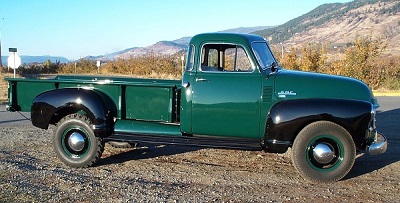
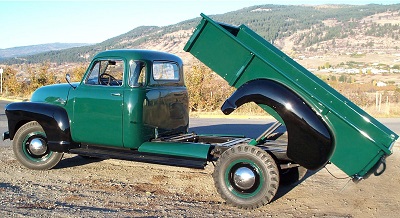
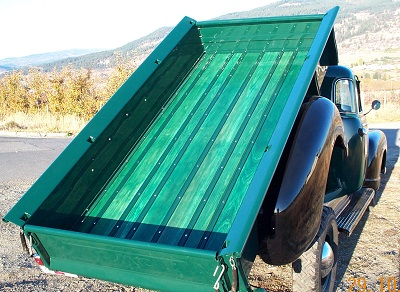
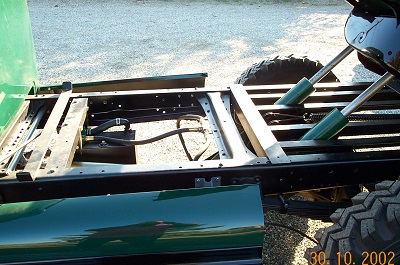
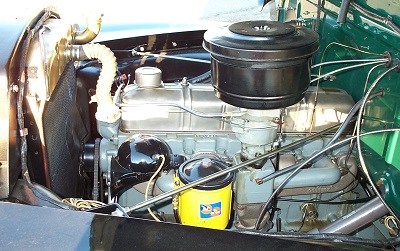
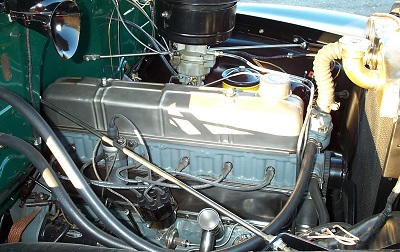
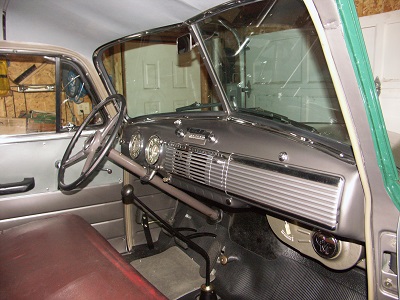
Greg's Collection




